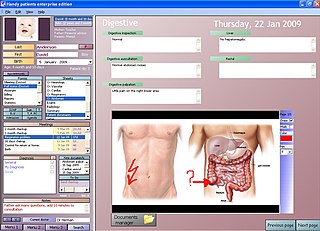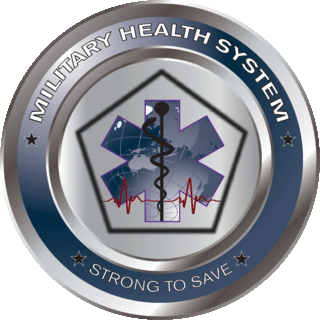Related Research Articles

The Defense Advanced Research Projects Agency (DARPA) is a research and development agency of the United States Department of Defense responsible for the development of emerging technologies for use by the military.

The United States Department of Health and Human Services (HHS), is a cabinet-level executive branch department of the U.S. federal government created to protect the health of all Americans and providing essential human services. Its motto is "Improving the health, safety, and well-being of America". Before the separate federal Department of Education was created in 1979, it was called the Department of Health, Education, and Welfare (HEW).

Health informatics is the field of science and engineering that aims at developing methods and technologies for the acquisition, processing, and study of patient data, which can come from different sources and modalities, such as electronic health records, diagnostic test results, medical scans. The health domain provides an extremely wide variety of problems that can be tackled using computational techniques.
The National Cancer Institute (NCI) coordinates the United States National Cancer Program and is part of the National Institutes of Health (NIH), which is one of eleven agencies that are part of the U.S. Department of Health and Human Services. The NCI conducts and supports research, training, health information dissemination, and other activities related to the causes, prevention, diagnosis, and treatment of cancer; the supportive care of cancer patients and their families; and cancer survivorship.

An electronic health record (EHR) is the systematized collection of patient and population electronically stored health information in a digital format. These records can be shared across different health care settings. Records are shared through network-connected, enterprise-wide information systems or other information networks and exchanges. EHRs may include a range of data, including demographics, medical history, medication and allergies, immunization status, laboratory test results, radiology images, vital signs, personal statistics like age and weight, and billing information.
The Composite Health Care System (CHCS) is a medical informatics system designed by Science Applications International Corporation (SAIC) and used by all United States and OCONUS military health care centers. In 1988, SAIC won a competition for the original $1.02 billion contract to design, develop, and implement CHCS.

The United States Navy Medical Service Corps is a staff corps of the U.S. Navy, consisting of officers engaged in medical support duties. It includes healthcare scientists and researchers, comprising around 60% of its personnel, and healthcare administrators, comprising the remaining 40%. Many of the latter are former enlisted hospital corpsmen, the Medical Service Corps Inservice Procurement Program (MSC-IPP) being one of several routes from enlisted service to commissioned status. The Medical Service Corps has around 2,600 serving commissioned officers.
Harris Corporation was an American technology company, defense contractor, and information technology services provider that produced wireless equipment, tactical radios, electronic systems, night vision equipment and both terrestrial and spaceborne antennas for use in the government, defense and commercial sectors. They specialized in surveillance solutions, microwave weaponry, and electronic warfare. In 2019, it merged with L3 Technologies to form L3Harris Technologies.
Medical Communications for Combat Casualty Care (MC4) is a deployable health support information management system of the U.S. Army.
A clinical coder—also known as clinical coding officer, diagnostic coder, medical coder, or nosologist—is a health information professional whose main duties are to analyse clinical statements and assign standard codes using a classification system. The data produced are an integral part of health information management, and are used by local and national governments, private healthcare organizations and international agencies for various purposes, including medical and health services research, epidemiological studies, health resource allocation, case mix management, public health programming, medical billing, and public education.
The Assistant Secretary of Defense for Health Affairs is chartered under United States Department of Defense Directive (DoDD) 5136.1 in 1994. This DoDD states that the ASD(HA) is the principal advisor to the U.S. Secretary of Defense on all "DoD health policies, programs and activities." In addition to exercising oversight of all DoD health resources, ASD(HA) serves as director of the Tricare Management Activity.

The Military Health System (MHS) is a form of nationalized health care operated within the United States Department of Defense that provides health care to active duty, Reserve component and retired U.S. Military personnel and their dependents.

The Department of Defense Serum Repository is a biological repository operated by the United States Department of Defense containing over 50,000,000 human serum specimens, collected primarily from applicants to and members of the United States Uniformed Services.
Health information technology (HIT) is health technology, particularly information technology, applied to health and health care. It supports health information management across computerized systems and the secure exchange of health information between consumers, providers, payers, and quality monitors. Based on an often-cited 2008 report on a small series of studies conducted at four sites that provide ambulatory care – three U.S. medical centers and one in the Netherlands – the use of electronic health records (EHRs) was viewed as the most promising tool for improving the overall quality, safety and efficiency of the health delivery system.
Athenahealth is a private American company that provides network-enabled services for healthcare and point-of-care mobile apps in the United States.
AHLTA is a global Electronic Health Record (EHR) system used by U.S. Department of Defense (DoD). It was implemented at Army, Navy and Air Force Military Treatment Facilities (MTF) around the world between January 2003 and January 2006. It is a services-wide medical and dental information management system. What made AHLTA unique was its implementation date, its Central Data Repository, its use in operational medicine and its global implementation. There is nothing like it in the private sector.

The Assistant Secretary of the Army for Installations, Energy and Environment is a civilian office within the United States Department of the Army.
The National Center for Telehealth & Technology (T2) is one of the Defense Centers of Excellence for Psychological Health and Traumatic Brain Injury (DCoE), a part of the Military Health System (MHS). T2 was originally established to lead the integration of behavioural sciences with technology to provide solutions for psychological health and traumatic brain injury (TBI). T2 is a principal coordinator of United States Department of Defense (DoD) initiatives involving telehealth, online health tools, suicide surveillance and prevention, and information technology.

The Defense Health Agency (DHA) is a joint, integrated combat support agency that enables the U.S. Army, U.S. Navy, U.S. Air Force, and U.S. Space Force medical services to provide a medically ready force and ready medical force to Combatant Commands in both peacetime and wartime. The DHA supports the delivery of integrated, affordable, and high quality health services to MHS beneficiaries and is responsible for driving greater integration of clinical and business processes across the MHS.
References
- ↑ "DHIMS | Defense Health Information Management System". Archived from the original on 2009-12-21. Retrieved 2019-08-17.
- ↑ [ permanent dead link ]
- ↑ "Defense Health Information Management System" (PDF). Archived from the original (PDF) on 2011-11-15. Retrieved 17 March 2021.
- ↑ "DHIMS | Defense Health Information Management System". Archived from the original on 2012-02-23. Retrieved 2019-08-17.